Hot Tub Ozonators: Simplify Maintenance and Enhance Water Quality
July 29th, 2024
July 29th, 2024
In the cozy sanctuary of your backyard, the hot tub stands as a beacon of relaxation and luxury. Yet, maintaining that bubbling haven can often feel like a chore. Enter the ozonator—a compact device promising to simplify hot tub care by purifying water with ozone gas. This clever gadget piques curiosity and skepticism alike, prompting enthusiasts to wonder whether its benefits justify the investment.
My friend Sarah swears by her ozonator, claiming it's reduced her reliance on harsh chemicals while keeping her tub pristine. Every time I visit, she insists on showing off the crystal-clear water—a testament, she says, to the power of ozone. I have to admit, there's an inviting clarity to her tub that’s hard to ignore.
Ozone, a molecule with three oxygen atoms, acts as a powerful oxidizer. When injected into hot tub water, it neutralizes contaminants more effectively than traditional sanitizers like chlorine or bromine. However, questions linger about its long-term efficacy and cost-effectiveness. Are these devices truly the silver bullet for spa maintenance, or do they merely add another layer of complexity?
In this exploration, we’ll navigate through the claims and counterclaims, dissect user experiences, and consult expert opinions. The goal is to uncover whether ozonators genuinely enhance the hot tub experience or if they're just another gadget vying for your attention. Let's embark on this journey, shedding light on whether embracing this technology could transform your soak time bliss.
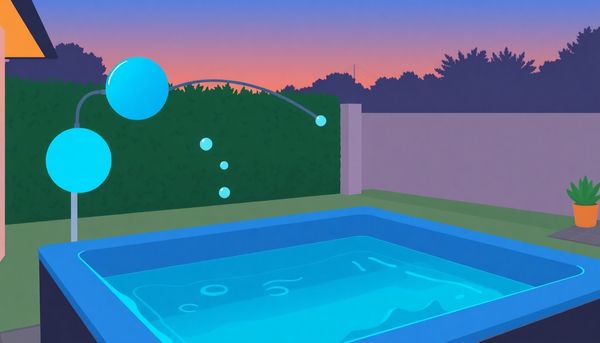
When considering the perks of adding an ozonator to your hot tub, envision a cleaner, more refreshing soak with fewer chemicals. By generating ozone gas, these devices significantly diminish the need for traditional sanitizers like chlorine and bromine. This reduction isn’t just a win for your wallet, but it also enhances the bathing experience, especially for those with sensitive skin or allergies, who often face irritation from chemical exposure.
The process is simple yet effective. Ozone, a potent disinfectant, attacks and neutralizes bacteria and contaminants through oxidation. This means your water stays pristine and clear without the hefty chemical load. Moreover, with the ozonator doing most of the heavy lifting, the need for regular shocking is minimized. Ozone even helps break down combined chlorine and bromine molecules, freeing up these sanitizers to keep working, thus extending their efficacy and reducing waste.
However, not every story is without its challenges. Installing an ozonator might come with upfront costs and potential complications, like ensuring it doesn’t harm vinyl hot tub covers. A thermal blanket can offer a solution, safeguarding your investment and preventing heat loss. All things considered, the notable decrease in chemical use and the promise of a more natural soak make a compelling case for ozonators, particularly for those prioritizing a healthier, more sustainable hot tub experience.
When considering the merits of a hot tub ozonator, the benefit of enhanced water quality often takes center stage. Imagine sinking into a tub of water that's not only inviting but also refreshingly clean, with minimal chemical interference. Ozonators achieve this by infusing ozone gas into the water, a natural powerhouse that zaps away up to 99% of bacteria and other pesky contaminants. This process, known as oxidation, dramatically reduces the need for chlorine or bromine.
My own experience with an ozonator has transformed the hot tub ritual. Before installing one, balancing chemical levels felt like a never-ending juggling act. Now, the water maintains a clarity and softness that friends compare to swimming in a pristine lake. The reduction in chemical usage—by up to 90%—means less skin irritation, a blessing for those sensitive to chemicals.
The ozonator doesn't just stop at cleaning; it enhances the overall hot tub experience by breaking down lotions, oils, and other residues left behind. This means less frequent shocking of the tub, preserving water quality for longer durations. While there's some upfront investment in installation and upkeep, the trade-off is palpable in the water's purity and the peace of mind it brings. For those ready to invest in a more natural and effective cleaning system, an ozonator might just be the game-changer your hot tub needs.
In a world where everyone seems to be searching for ways to simplify life and reduce chemical exposure, hot tub ozonators offer a refreshing solution for spa enthusiasts. By integrating an ozonator into your hot tub setup, the reliance on traditional sanitizers like chlorine or bromine can be substantially minimized. This innovation doesn't just promise cleaner water; it provides an opportunity to enjoy a healthier soak with fewer skin irritations and unpleasant odors. My cousin, an avid hot tub user, made the switch last year and noticed an immediate difference in the smell and feel of the water, finding it gentler on his sensitive skin.
Ozonators work by injecting ozone gas into the water, which effectively breaks down bacteria and other contaminants, reducing the need for harsh chemicals. This means that the once-dreaded chore of maintaining perfectly balanced water becomes less burdensome, allowing more time to enjoy the tub rather than fuss over it. Additionally, less chlorine in the water equates to a more eco-friendly practice, which is a bonus for environmentally conscious users.
However, it's important to balance the benefits with the potential drawbacks. The initial investment and occasional maintenance costs can add up, and care must be taken to protect certain hot tub components from ozone's reactive nature. With that said, for those seeking a cleaner, more natural hot tub experience, reducing chemical dependency through the use of an ozonator may just be the perfect solution.
Owning a hot tub can be a relaxing escape, but the upkeep? Not so much. Enter the hot tub ozonator—a little device that can take a big chunk out of your maintenance routine. Instead of constantly juggling a cocktail of chemicals to keep your water pristine, an ozonator steps in as a silent partner, reducing your reliance on traditional sanitizers like chlorine and bromine. With fewer chemicals, there's less worry about balancing pH levels and less frequent water testing.
Have you ever spent a lazy afternoon fishing out test strips, only to be greeted by a chemical soup of murky readings? An ozonator minimizes these moments. The ozone it produces breaks down contaminants efficiently, which means less residue and fewer fluctuations in your water chemistry. It’s like having a diligent housekeeper who’s always on the job, invisibly tidying up after every soak.
While maintenance does become simpler, it's not entirely set-and-forget. Regular checks ensure the ozone is reaching your tub and doing its job. Inspect the check valve and ozone injector periodically to avoid any hiccups. Despite these small tasks, maintaining an ozonator is straightforward compared to the constant chore of chemical adjustments. In the long run, this can mean more time enjoying your hot tub, and less time worrying about it, making those sunset soaks just that little bit sweeter.
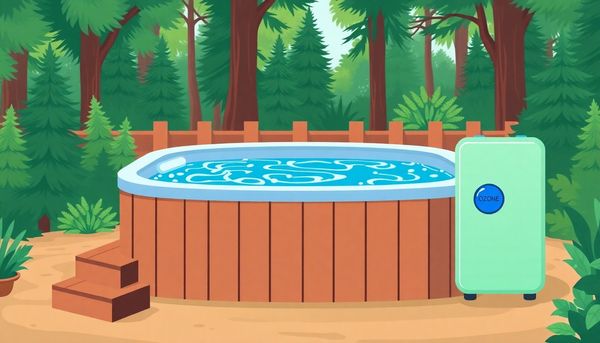
A casual evening soak in a hot tub may seem like a harmless luxury, but the invisible forest of chemicals often lurking beneath those bubbles can tell a different tale. Enter the hot tub ozonator, a device that seeks to shift the balance from chemical-laden to more naturally sanitized waters. By introducing ozone gas into the water, ozonators break down unwanted contaminants, effectively reducing the need for traditional sanitizers like chlorine or bromine by up to 90%.
Consider this: a friend of mine, who loves his evening soaks yet detests the persistent smell of chlorine, installed a hot tub ozonator last summer. Much to his delight, the pungent aroma that once lingered on his skin and towels is practically a memory now. With significantly reduced chemical levels, his hot tub sessions have become more enjoyable and less harsh on his skin and hair.
While the initial setup of an ozonator might seem daunting, the long-term benefits of reduced chemical use can be compelling. Not only does it make the hot tub experience more pleasant, but it also minimizes the routine of constant chemical adjustments and tests. This simplicity, paired with the environmental benefits of using fewer chemicals, makes ozonators an attractive option for those seeking a cleaner, greener hot tub experience. Nonetheless, as with any worthwhile investment, it’s crucial to weigh the benefits against potential downsides like installation costs and maintenance.
Proper installation of an ozonator is essential for maximizing its benefits and ensuring your hot tub remains in top condition. Begin by assessing whether your hot tub is "ozonator ready." This usually means it has an existing connection for the ozonator, saving you some hassle. If not, you might need to engage in a bit of DIY plumbing or call in a professional for assistance.
Identify the ideal location for your ozonator, often inside the spa cabinet or nearby. The unit requires sufficient space for airflow, so avoid cramped spaces. If your tub features an ozonator jet, connect it directly to your unit. Otherwise, some plumbing adjustments may be necessary, and your tub's manual can be invaluable here.
Once connected, focus on the vinyl tubing and check valve. The check valve, a vital component, prevents water from backflowing into the ozonator. Install this valve by cutting the tubing and fixing the valve about six inches from the connection point, ensuring the flow direction is correct. The Hartford Loop is another smart addition, where you loop the tubing above the water line, adding extra security against water backflow.
Electrical work is the final step. You have the option to plug the ozonator into an outlet or hardwire it to the hot tub’s system. If you choose the latter, consulting an electrician is advisable, especially if you're not comfortable with electrical work. With everything set up, adjust the ozonator's timer to sync with your hot tub usage, ensuring optimal sanitation. Regular maintenance checks, particularly on the check valve and ozone levels, will keep your system running smoothly.
Selecting the appropriate ozonator for your hot tub can feel like navigating a labyrinth of choices. Each type offers unique benefits and potential drawbacks, tailored to different environmental conditions and usage needs. Understanding these distinctions is key to making an informed decision that matches your lifestyle and hot tub setup.
First, consider the Corona Discharge (CD) ozonators. These are like the dependable workhorses of the ozonator world. They employ a corona discharge technique, which is highly efficient at generating ozone. If you are someone who enjoys frequent spontaneous soaks, a CD ozonator's long lifespan and minimal maintenance requirements could be a perfect match. They're particularly suitable for larger water capacities, offering reduced chemical use and enhanced sanitation. However, if you happen to live in a humid environment, their effectiveness might dwindle, prompting you to consider other options.
On the other hand, Ultraviolet (UV) ozonators work by using UV light to produce ozone. These systems shine in their ability to function unaffected by humidity, making them ideal for those living in coastal or tropical regions. Despite their shorter lifespan and potentially higher operational cost for larger tubs, they serve as a reliable option for consistent ozone output in any climate. If the thought of regular bulb replacement doesn’t deter you, UV ozonators offer a flexible and effective solution.
Ultimately, the choice between a CD and a UV ozonator hinges on your specific conditions and priorities. Assessing factors like climate, hot tub size, and personal convenience will guide you to the right fit, ensuring you enjoy crystal-clear waters with minimal fuss.
Balancing the chemical levels in a hot tub can feel like a chemistry experiment gone awry. However, with the introduction of a hot tub ozonator, this task becomes significantly less daunting. Picture this: fewer bottles of chlorine lining your shelves, less irritation on sensitive skin, and a more enjoyable soak, all thanks to the magic of ozone. Ozone (O3), a powerful oxidizer, breaks down contaminants in the water, rendering them harmless. Consequently, the need for traditional sanitizers like chlorine or bromine is minimized, usually down to about 0.5 PPM and 1.0 PPM, respectively.
My neighbor swears by her ozonator, often mentioning how much less frequently she needs to dip into her stash of pool chemicals. This doesn't mean you can toss away those test strips, though. Regular monitoring remains key to maintaining that delicate balance between too little and too much sanitizer. The ozonator doesn’t replace the need for all chemicals; rather, it streamlines the process, allowing the water to stay clearer with less effort involved.
Still, there’s a trade-off to be aware of. Ozone’s reactivity, while beneficial for water cleaning, can potentially damage the hot tub cover. A simple solution is employing a thermal blanket to buffer this effect. In essence, an ozonator provides a safer, more efficient way to manage chemical levels, enhancing the hot tub experience without the usual chemical cocktail.
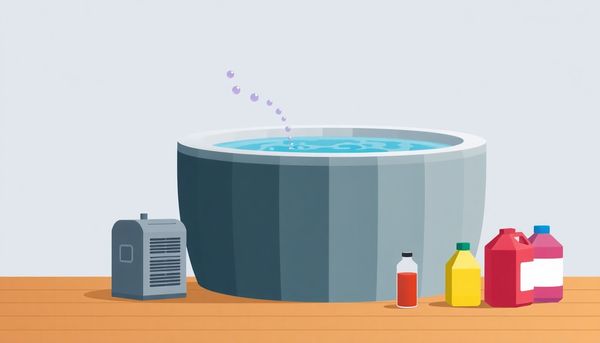
The initial thrill of owning a hot tub ozonator often meets a speed bump when it comes to installation. This seemingly small gadget can make a big difference in water quality and chemical usage, but getting it up and running isn't always straightforward. The installation process might remind you of assembling a complex piece of furniture without clear instructions, leading to more head-scratching moments than anticipated.
For starters, not every hot tub is prepped for an ozonator, even if it claims to be "ozonator ready." The sight of a tiny jet with a capped air tube in your spa cabinet might make you think, "What now?" Connecting these parts requires precision, and the one-way check valve must be installed correctly to prevent water backflow—a task that can turn into a plumbing puzzle if you're not careful. The Hartford Loop, a clever design to stop water from reaching the ozonator, adds another layer of complexity. Trust me, attempting to figure this out on your own can be like trying to solve a Rubik's Cube blindfolded.
Moreover, the electrical aspect shouldn't be underestimated. If you're not comfortable playing electrician, it's wise to call in a professional. Missteps here aren't just frustrating; they can damage your hot tub system. Taking the time to ensure the installation is done correctly can save not only your peace of mind but also the longevity of your hot tub and its components.
Choosing the right ozonator for your hot tub isn't simply a matter of purchase and plug-in. The real art lies in understanding the compatibility between the unit and your specific hot tub system. Across the spectrum of tub models, most can accommodate an ozonator, but there are nuances to consider. For instance, the installation method varies; some newer models come "ozonator ready," simplifying the process with pre-existing ports.
It’s essential to match the right ozonator type—Corona Discharge (CD) or Ultraviolet (UV)—with your climate conditions. While CD ozonators boast a longer lifespan and efficiency, high humidity climates can impede their function. On the other hand, UV ozonators, unaffected by humidity, might be a more reliable choice if you reside in a moisture-heavy area.
Reflecting on my own experience, I opted for a CD ozonator, given its efficiency, but quickly learned about the importance of ensuring proper airflow around the unit. It’s akin to giving your car enough road to drive on—without it, you’re not going anywhere fast. That’s why consulting your hot tub's manual or a professional can be invaluable. This ensures the ozonator integrates seamlessly, maximizing its potential without compromising your tub's integrity. Balancing these considerations will guide you towards a decision that optimizes both effectiveness and longevity.
Humidity often plays the role of an uninvited guest when it comes to maintaining a hot tub ozonator. Imagine having a reliable Corona Discharge (CD) ozonator, a top performer in the ozone generation world, only to find it struggling in a high humidity environment. This is because moisture in the air meddles with the ozone production process, reducing efficiency and effectiveness. It’s akin to trying to light a match in a rainstorm; the conditions just aren’t conducive to success.
In particularly humid areas, where humidity exceeds 60%, a CD ozonator may not be the best choice. This doesn’t mean you’re out of options, though. For those residing in muggy climates, Ultraviolet (UV) ozonators can be a savior. They operate differently and aren’t fazed by the moisture in the air. Although they might not pack the same punch in terms of power as CD ozonators, they provide a reliable alternative where ambient humidity is high.
Understanding these limitations allows you to tailor your hot tub system to your specific environment. By selecting the right type of ozonator for your climate, you ensure the water remains pristine, without battling the elements. It’s about finding harmony between technology and nature, ensuring that every soak in your hot tub is as refreshing and worry-free as it should be.
Embarking on the journey of installing a hot tub ozonator requires more than just basic know-how; it demands attention to detail and precision. Imagine your ozonator as the unsung hero of your spa experience, silently ensuring optimal hygiene while reducing your reliance on traditional chemicals. A successful installation hinges on understanding the nuances of your hot tub's design and the ozonator's requirements.
Begin by assessing your hot tub's readiness. Many modern models come "ozonator-ready," simplifying the process. These tubs often feature a dedicated ozone jet, designed to seamlessly integrate the ozonator. If your hot tub lacks this feature, a touch of plumbing expertise, or the assistance of a professional, will be necessary to create the correct setup. Positioning the ozonator inside the spa cabinet requires a secure mount and ample airflow to ensure longevity and efficiency.
Connecting the ozonator involves more than just attaching hoses; it involves creating a reliable system that prevents water backflow. The inclusion of a one-way check valve in your installation is paramount. This small component is vital in protecting your ozonator from potential damage caused by water ingress. For an extra layer of defense, consider forming a Hartford Loop with your tubing, elevating it above the water line to shield against unexpected backflow issues.
Powering your ozonator can be achieved either by plugging into a standard outlet or by hardwiring it for synchronized operation with your hot tub’s main system. If hardwiring seems daunting, don't hesitate to hire an electrician. Once installed, fine-tune the ozonator's operation based on your hot tub's usage and water conditions. A bit of experimentation might be necessary to strike the perfect balance, ensuring both water clarity and ozonator efficiency.
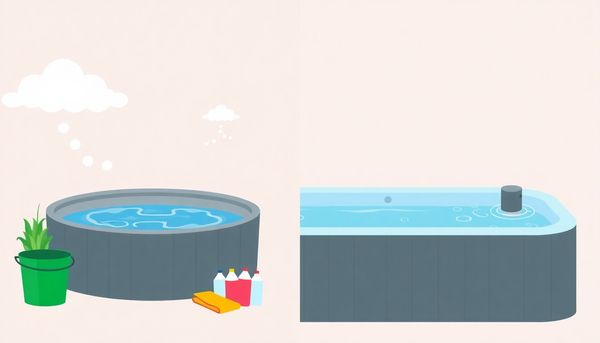
In the world of hot tub maintenance, choosing between Corona Discharge (CD) and Ultraviolet (UV) ozonators can be akin to picking the right tool for a delicate craft. Each has its unique advantages and drawbacks, making the decision largely dependent on personal needs and environmental conditions.
Corona Discharge ozonators often stand out due to their efficiency and longevity. By utilizing advanced technology, they create a plasma curtain through which oxygen molecules are split to form ozone. This method is not only powerful—efficiently destroying up to 99% of bacteria and contaminants—but also cost-effective over time. With no need for frequent part replacements, CD ozonators boast an extended lifespan, sometimes reaching up to a decade. However, they do have an Achilles' heel: high humidity can impair their function, which is something to keep in mind if your spa is located in a particularly moist environment.
On the other side, UV ozonators harness the power of ultraviolet light to generate ozone. While they may lack the punch of CD models in terms of output and longevity, UV ozonators have their perks. They thrive in any climate, unaffected by humidity, and can be a reliable option for those with varying environmental conditions. Yet, the necessity for regular bulb replacements every couple of years and potentially higher operational costs for large tubs might sway the decision for some users.
Ultimately, whether you opt for a CD or UV ozonator hinges on balancing efficiency, maintenance, and the specific conditions of your hot tub environment.
When it comes to choosing a hot tub ozonator, understanding both its efficiency and lifespan can guide your decision. While ozonators promise sparkling, bacteria-free water with minimal chemical use, not all systems are created equal. The Corona Discharge (CD) ozonator stands out for its impressive efficiency, capable of reducing chemical usage by up to 90%. This type of ozonator operates through a corona discharge, which splits oxygen molecules to form ozone, effectively neutralizing contaminants. The lack of replaceable parts like bulbs or cartridges further extends its lifespan, often reaching up to a decade under optimal conditions.
Despite these advantages, not every environment suits a CD ozonator. High humidity levels can impede its performance, making it less effective in certain climates. On the other hand, the Ultraviolet (UV) ozonator offers a different set of benefits. It's unaffected by humidity, making it a reliable choice in moist conditions. However, its shorter lifespan and lower efficiency mean higher maintenance costs, as the UV bulb requires replacement every few years.
Deciding between these options involves balancing initial investment and ongoing maintenance against the benefits of reduced chemical use and prolonged equipment life. Your geographical location and specific hot tub setup play crucial roles in determining which ozonator will efficiently meet your needs while offering the longest service life.
When considering a hot tub ozonator, the path from purchase to installation is a journey worth exploring. First and foremost, let's talk cost. An ozonator can range from $100 to $400, depending on the type and brand. While this upfront investment might seem steep, it's important to factor in the substantial reduction in chemical expenses over time. Many users find that the cost savings on chlorine and bromine alone can make the initial expenditure worthwhile, not to mention the added benefit of softer, more natural-feeling water.
Installation, however, can be a different beast altogether. If your hot tub is already "ozonator ready," you're halfway there, with dedicated connections simplifying the process. Still, if tackling plumbing and electrical components isn't your forte, hiring a professional might be the best route. A professional installation ensures that the ozonator is set up correctly, maximizing efficiency and preventing potential mishaps like backflow damage.
There's also the consideration of ongoing maintenance. Ozonators require periodic checks and possible part replacements, such as the check valve or the ozone injector. These parts are crucial for the system's proper functioning and longevity. Neglecting these components can lead to diminished performance or even damage. Balancing these costs and efforts against the benefits of an ozonator is key to making an informed decision on whether this device is right for your hot tub experience.
When considering the upkeep of a hot tub ozonator, it's crucial to understand its role and the minor responsibilities it brings. An ozonator reduces your reliance on chemical sanitizers, making maintenance a bit simpler but still requiring attention. Unlike adding chlorine or bromine constantly, an ozonator primarily needs regular checks to ensure it's functioning effectively.
Firstly, make a habit of inspecting the ozonator’s check valve and tubing. These components guard against water backflow, which could compromise the unit. Think of it as your routine car oil check—simple yet essential to avoid major issues. If you notice any leaks or wear, it's time for a replacement to keep the system working smoothly.
Moreover, testing your water with ozone test strips helps verify the ozonator’s effectiveness. This is akin to checking your tire pressure before a long drive; it ensures safety and efficiency. Should you find the ozone levels low, it might not be the ozonator itself, but the injector needing a clean or replacement.
In terms of lifespan, Corona Discharge (CD) ozonators can last up to a decade with minimal maintenance, while Ultraviolet (UV) units often require bulb changes every few years. This longevity can lead to significant savings on chemical costs, though initial installation might seem pricey. Remember, a well-maintained ozonator not only extends its life but also enhances your hot tub experience by maintaining crystal clear water with minimal chemical use.
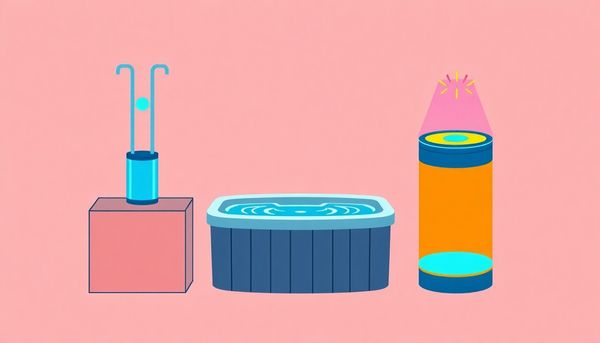
The quest for pristine hot tub water often feels like a balancing act, juggling chemical levels and water clarity. A hot tub ozonator steps in as a game-changer, optimizing water sanitation with minimal chemical interference. Unlike traditional methods that rely heavily on chlorine or bromine, the ozonator uses ozone gas (O3) to tackle bacteria and impurities through oxidation. This method not only slashes chemical use by up to 90% but also enhances the overall bathing experience, particularly for those with sensitive skin.
Consider the benefits of reduced chemical dependency. For instance, imagine enjoying a soak without the pungent smell of chlorine or the irritation it can cause to your skin and eyes. Ozonators efficiently maintain sanitized water, requiring only minimal levels of additional sanitizers—0.5 PPM for chlorine and 1.0 PPM for bromine, compared to the usual higher concentrations. This shift not only cuts down on chemical costs but also fosters a more natural water feel.
However, keeping an eye on ozone levels is crucial. Regular testing with ozone test strips ensures the system functions optimally, maintaining the delicate balance between cleanliness and comfort. While installing and maintaining an ozonator might seem daunting at first, the long-term benefits can significantly outweigh the initial setup complexities. Embracing this technology means less time worrying about water balance and more time savoring the serenity of your hot tub retreat.
Incorporating an ozonator into your hot tub setup can transform your relaxation ritual into a cleaner, more enjoyable experience. Imagine lounging in crystal-clear water, knowing that you're reducing chemical exposure while maintaining hygiene. An ozonator introduces ozone gas into the water, significantly reducing reliance on chlorine or bromine. This means fewer chemicals for your skin to contend with, ideal for those with sensitivities.
But before you enjoy these benefits, installation is a key step that requires careful execution. Placing the ozonator inside the spa cabinet is typically straightforward, with a dedicated hose directing ozone to the water jets. This setup transforms contaminants, such as body oils and lotions, into harmless compounds, aiding in water cleanliness. Just like fitting a new gadget into your daily routine, it might feel cumbersome initially, yet the long-term advantages are undeniable.
However, the process isn’t without its challenges. Incorrect installation can compromise your hot tub and ozonator’s efficiency. It’s crucial to incorporate a check valve to prevent backflow that could damage the unit. And while the initial setup might seem daunting, enlisting a professional can alleviate concerns of mishaps. Think of it as an investment in both time and peace of mind, ensuring your relaxing soaks are truly carefree.
Ultimately, installing an ozonator not only enhances water quality but also reflects a commitment to maintaining a healthy, eco-conscious environment for you and your loved ones. Like any worthwhile endeavor, it requires some effort, yet the results speak volumes, making each soak a purer escape.
Balancing chemicals in a hot tub can feel like a juggling act, but an ozonator offers a helping hand. By injecting ozone gas into the water, it efficiently sanitizes the tub, allowing you to significantly cut back on chlorine and bromine. Typically, with an ozonator in place, chlorine can be maintained at a mere 0.5 PPM and bromine at 1.0 PPM. This is a dramatic decrease from the usual 1-3 PPM for chlorine and 3-5 PPM for bromine, reducing not only chemical exposure but also the effort and cost involved in maintaining your spa.
A friend of mine who swears by her hot tub as her relaxation haven recently installed an ozonator, and she’s thrilled with the results. She mentioned how her skin feels less irritated, and she no longer dreads that post-soak chemical smell. Her lesson? Regular water testing is crucial to ensure these optimal levels are maintained. This ensures the sanitizer remains effective, providing a crystal-clear and inviting soak every time.
However, the benefits of lower chemical usage come with their own set of responsibilities. Monitoring is key—although reduced, you still need to keep chlorine or bromine in check. Regularly testing your hot tub water safeguards the balance and ensures you continue enjoying the perks of a cleaner, fresher soak without over-relying on traditional sanitizers.
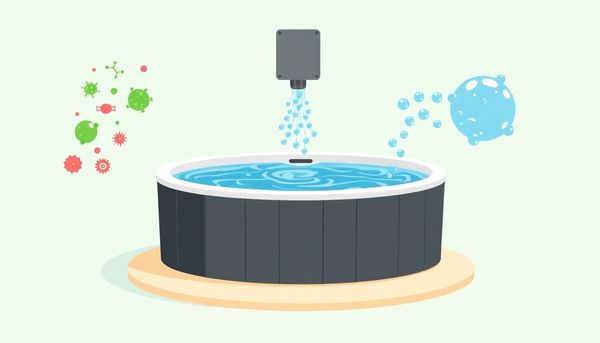
This article provided insights into maintaining your pool. Start your pool care journey today!
Want to become a pool maintenance expert? Our free Pool School course covers everything you need to know about pool care. From basic maintenance to advanced troubleshooting, you'll learn how to:
Join over 10,000 pool owners who have already transformed their pool care routine. Get started with our free Pool School course today!